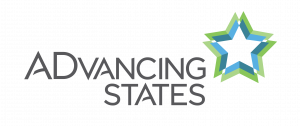Nursing Facility Transitions
MINNESOTA
Identified Problems with the State's Long-Term Care System
- Insufficient supply of affordable, accessible community housing.
- Lack of information among the general public and among long-term care professionals about community options and the potential for nursing facility transition.
Perceived Strengths
The statewide network of Centers for Independent Living (CILs), and its statewide membership association, Minnesota Association of CILs (MACIL) maintain strong collaborative relationships that has resulted in significant legislative and policy changes over the last several years.
Primary Focus of Grant Activities
- Promote awareness about new nursing facility transition (NFT) initiatives among waiver staff, consumers, and the general public.
- Provide individuals who wish to transition with information, referrals, and support.
- Ensure the availability of affordable and accessible housing for individuals choosing to live interdependently in the community.
Goals, Objectives, and Activities
Overall Goal. Enhance the infrastructure that supports people who want to transition from nursing facilities, by providing information to consumers and professionals, developing regional partnerships to support NFT, and developing a public policy agenda to address housing barriers to transition.
Goal. Provide training and information regarding NFT and available community supports to consumers and social service professionals.
Objectives/Activities
- Create a consumer-friendly brochure for consumers and the general public that will summarize information regarding available NFT assistance and home and community service options.
- Create a brochure, an informational booklet, and an 18–minute video for social service professionals explaining NFT and how to gain additional information and assistance with transitions. These materials will be distributed by the CILs, the Minnesota Department of Human Services, the State Council on Disability, county social service staff (who provide Medicaid waiver case management), Area Agencies on Aging, and local public and private agencies that support people with disabilities.
- Create an easy guide for consumer self-assessment for those desiring to transition from nursing homes/institutions to community-based living.
- Conduct training between CILs and county social service agencies. County social service staff will train CILs regarding funding reimbursement opportunities for services; CILs will train county social service staff regarding NFT methods.
- MACIL and CIL staff will attend training by the Minnesota Department of Human Services regarding the department's development of a Housing Resource Center and Housing Database, which will provide a broad array of information on affordable, accessible housing in the state.
Goal. Develop public/private partnerships to secure additional local resources to support NFT and to increase awareness of the need for successful NFT in local communities.
Objectives/Activities
- CILs will develop partnerships with local nursing facility staff and advocates to support CILs' NFT efforts.
- CILs will develop regional forums for people involved in nursing facility transition. The forums will enable CIL community living specialists, consumers, and advocates to lend support to each others' efforts, train new community living specialists to facilitate transitions, develop regional resources for NFT, and advocate for systems change on a grassroots level when needed.
- Community living specialists will work with consumers to plan their move to the community, assist in teaching independent living skills, and provide peer/mentor relationships, advocacy supports and other services.
Goal. Create a collaborative effort among state agencies, consumers, advocates, architects, and developers to respond to the need for accessible and affordable housing for transitioning individuals.
Objectives/Activities
- Develop a survey instrument to collect information about the housing market in Region 8 (southwest Minnesota), such as the current market for affordable housing, the type of housing accessibility features required, and consumer housing demographics.
- Analyze the survey to determine the specific needs for accessible and affordable housing in Region 8. If the survey analysis demonstrates a specific need for accessible and/or affordable housing, the Southwest Minnesota Housing Project will solicit local foundations and grantors for funds to develop appropriate housing options.
- Based on the experience in Region 8, develop a housing assessment model for use in all other regions of the state and conduct the assessment.
- Present the findings of the assessment to consumers, advocates, state agencies, and housing industry representatives, to enlist their support to pursue constructive public policy remedies to the issue of accessible and affordable housing. A successful outcome will be the recognition of efforts to date, and the development of a specific legislative and public policy agenda to resolve the issue.
Key Activities and Products
- Create a consumer friendly brochure for county staff, consumers, and the general public that will summarize the information regarding programs to help in transitioning to the community.
- Create an easy guide for consumer self-assessment for those desiring to transition from nursing homes/institutions to community-based living.
- Increase awareness of the need for successful NFT in local communities by working closely with various partners.
- Advocate as a key informant to the appropriate state departments during development of public policy strategy on interdependent, community-based living.
- Develop partnerships with local nursing facility staff and advocates.
- Develop educational and promotional materials to assist with project efforts.
- Develop and analyze a survey instrument to assess housing issues in Region 8.
- Develop a housing assessment model for use in all other regions of the state.
- Present two forums focusing on the issue of accessible and affordable housing.
Consumer Partners
- People with disabilities form the majority of staff and boards of all CILs involved in the grant.
- Additional consumers identified by the CILs will be involved in providing input on implementation activities as described below.
Consumer Partners and Consumer Involvement in Planning Activities
Each of the eight CILs provided input, review and editing of the grant application.
Consumer Partners and Consumer Involvement in Implementation Activities
- All Minnesota CILs are required to have a staff and board complement of at least 50 percent people with disabilities. CIL staff will be used throughout the project as key participants, informants and resources.
- For each activity in the grant, people with disabilities and older adults will be involved in providing program input, participating in the design of training materials and public information brochures, and in conducting assessments of accessible/affordable housing needs.
- Consumers will be among the respondents of the housing survey to identify housing needs in the marketplace.
Public Partners
- Minnesota Department of Human Services.
- Minnesota Housing Finance Agency.
- State Council on Disability.
- County social services agencies.
Private Partners and Subcontractors
- Seven CILs.
- Minnesota Association of Centers for Independent Living (MACIL).
- The Southwest Minnesota Housing Partnership.
Public and Private Partnership Development/Involvement in the Planning Phase
Public Partners
The Department of Human Services, the Minnesota Housing Finance Agency, and the State Council on Disability participated in reviewing the grant application materials and offered critical review and comment.
Private Partners
Each of the eight CILs provided input, review and editing of the grant application. Letters of Agreement were created with each CIL (on file) that details the responsibility of their continued involvement.
Public and Private Partnership Development/Involvement in Implementation
Public Partners
- County social services agencies will train CILs regarding potential state and local funding sources for the community services and other assistance CILs provide.
- Minnesota Department of Human Services will provide training on the Housing Resource Center and Housing Database it is developing.
- Representatives from the Minnesota Housing Finance Agency and the State Council on Disability will participate in two forums held by MCIL and MACIL: one to gather information to design the housing market assessment, and one to construct a public policy agenda to address housing issues identified in the assessment.
Private Partners
- Each CIL will conduct several Grant activities in that CIL's region, including training county social service agencies, disseminating information brochures, and leading the regional forums for people and organizations supporting nursing facility transition activities.
- MACIL will coordinate and support all CILs' involvement in the grant.
- If the survey analysis demonstrates a specific need for accessible and/or accessible housing, the Southwest Minnesota Housing Project will solicit local foundations and grantors for funds to develop appropriate housing options for its residents.
Existing Partnerships That Will Be Utilized to Leverage or Support Project Activities
- MACIL has assisted the Minnesota Department of Human Services in providing nursing facility transition through a state-funded program. This program will support the CILs' efforts to help people transition as part of this grant.
- As part of the consumer information dissemination, MACIL will distribute a 25–minute video currently being produced in cooperation with the Department of Human Services. The video presents a series of anecdotal observations by consumers regarding their experiences with nursing home transitions.
Oversight/Advisory Committee
Oversight activities will be the responsibility of the Board of MACIL. The oversight committee or advisory committee will review all data generated by the project, will advise on the development of any project materials, and will assist in the dissemination of all project materials. The advisory board is made up of the eight directors of the CILS, many of whom are also consumers.
Formative Learning and Evaluation Activities
Results from the first housing survey for southwest Minnesota will inform the survey used for other regions of the state.
Evidence of Enduring Change/Sustainability
- Grant-produced materials will be available after the grant ends, including tangible products such as a training manual on successful nursing facility transitions, informational and educational brochures, and a housing survey and assessment model. Master copies will be maintained and further distributed by request.
- Other less tangible outcomes include a strong influence on public policy decisions, enhanced public/private partnerships, positive and constructive relationships with nursing facility representatives, and the development of a cadre of community specialists, consumers, and advocates to work in a collaborative effort.
Geographic Focus
Statewide.

